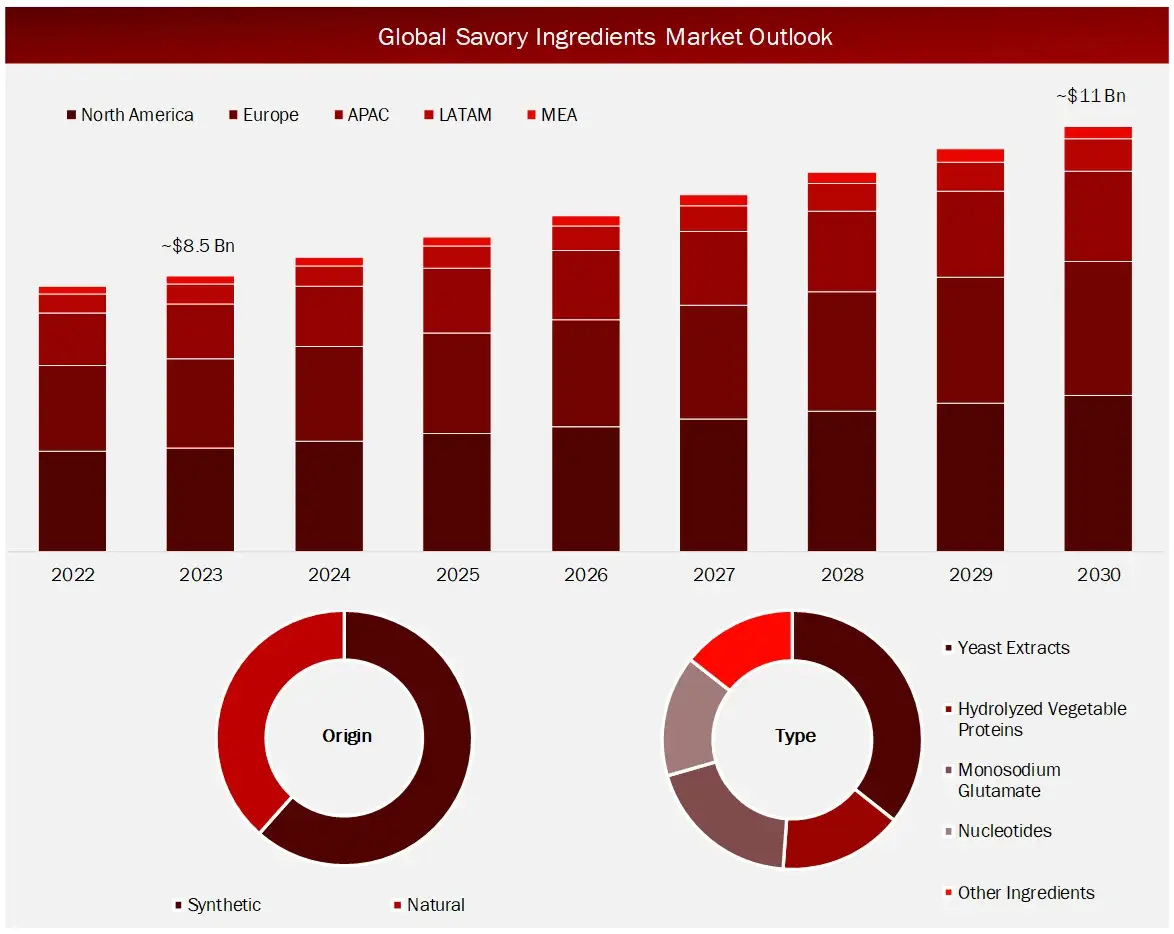
Wissen Research analyses that the global savory ingredients market is estimated at ~USD 8.5 billion in 2023 and is projected to reach ~USD 11.0 billion by 2030, expected to grow at a CAGR of ~5.0% during the forecast period, 2024-2030.
In recent years, savory ingredients have become widely accepted within the processed food industry, restaurants, and other food service establishments. Convenient food products like dehydrated noodles, soups, and ready meals contain savory ingredients. More snacks that have savory ingredients are chips, fruit snacks, nuts, popcorn, corn chips, among others. The market for savory ingredients embodies a broad spectrum of natural as well as synthetic products with applications in industries for instance, dietary supplements, food and beverages, and others. The market is being mainly influenced by the awareness for high nutritional ingredients and increasing demand for flavor enhancers.
Driving Factor: The increasing popularity of nutritional ingredients and advancements in food technology
The global market for savory ingredients has experienced significant growth in recent years due to the increasing popularity of packaged and ready-to-eat food products. Nutrient additives are anticipated to attract significant interest from the candy store and bakery sectors. There is anticipated growth in the demand for food additives in the upcoming years because of the increasing popularity of bakery products. Further, the increasing demand for low-fat foods from health-conscious consumers is propelling the worldwide market for savory ingredients. Innovation in the savory ingredients sector are anticipated to have a favorable effect on the worldwide savory ingredients market.
Opportunity: Increasing Shift towards Natural Ingredients and Products
Use of botanical / herbal sources has emerged as a popular alternative for savory ingredients. This can be attributed to the fact that plant-based ingredients appear to be effective and safer option compared to other sources with minimal risk of side effects. As more individuals adopt these natural solutions and personalized care, the market for savory ingredients is poised for significant expansion. Companies that leverage high nutritional clinically proven plant-based extracts effectively can gain a competitive edge and capitalize on the growing demand for natural savory ingredients.
Challenge: Interruptions in sustainability and supply chain are factors that hinder the savory ingredients market growth
Changes in regulations concerning food safety, labeling, and ingredient procurement present obstacles for businesses in the market. Interferences in the supply chain, such as, natural disasters, geopolitical events, or pandemics, can greatly affect the availability and price of important savory ingredients. These interruptions impact the production procedures and general stability of savory ingredient markets. Companies that heavily rely on resource-intensive or environmentally impactful sourcing practices face challenges due to the growing awareness of sustainability and environmental issues.
The savory ingredients market report offers information on the latest advancements in the industry, as well as product portfolio analysis, supply chain/value chain analysis, market share, and the effects of localized and domestic players. It also analyzes potential revenue opportunities and changes in market regulations, as well as market size, category market growth, application dominance, product approvals, product launches, geographic expansions, and technological innovations. For an analyst brief and other information on the savory ingredients market, get in touch with Wissen Research. Our staff can assist you in making well-informed decisions that will lead to market expansion.
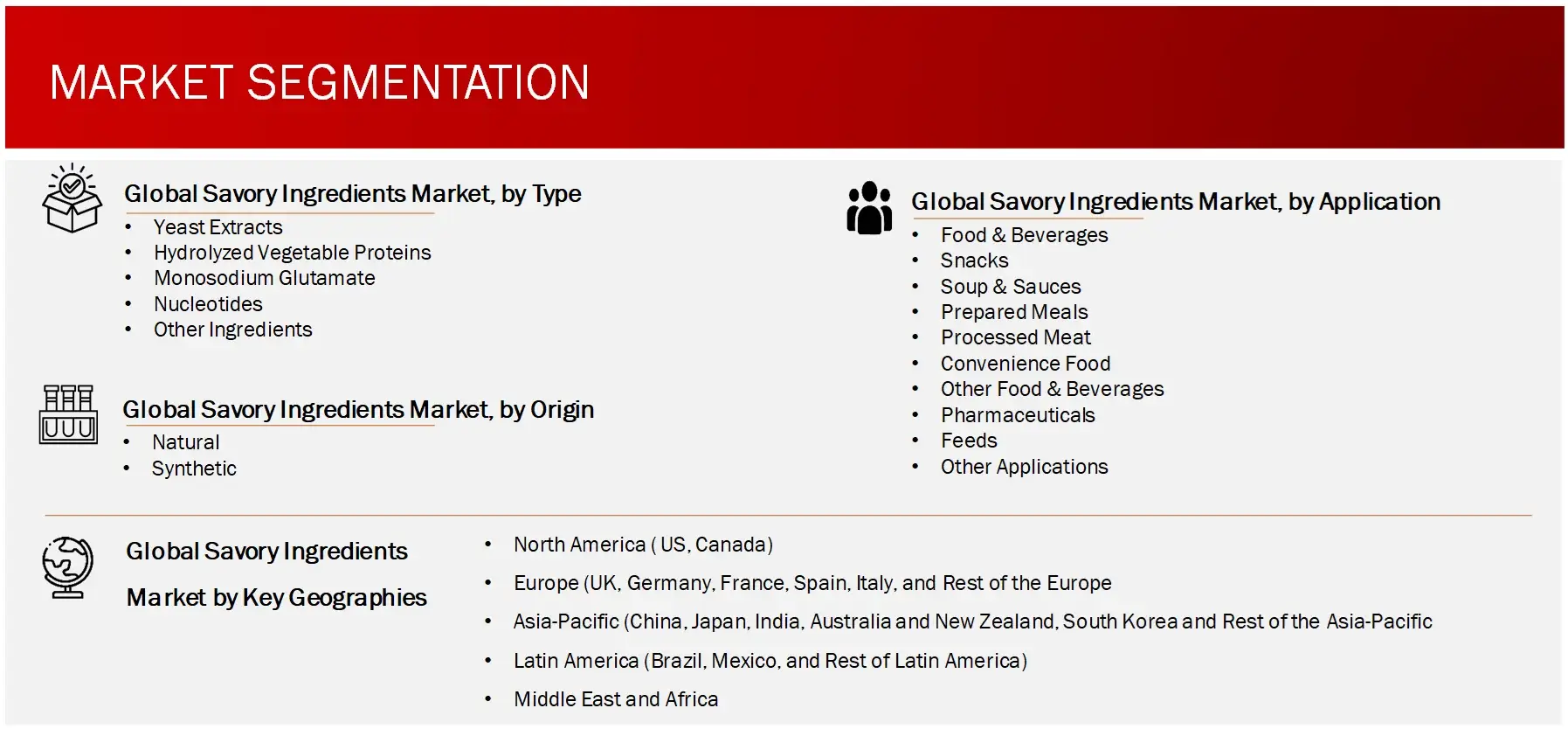
Natural savory ingredients are anticipated to grow at highest rate within the dietary savory ingredients market by product type
The savory ingredients market is segmented into natural and synthetic sources, based on origin. Owing to their natural origin and effective nutritional qualities, the natural savory ingredients demand is anticipated to increase at a noticeable yearly rate during the forecast period. Further, the increasing recognition and favoritism for ingredients that promote health are the main factors behind the growth of the natural savory ingredients market.
Monosodium Glutamate captured majority share of savory ingredients market by type
Yeast extracts, hydrolysed vegetable proteins, monosodium glutamate (MSG), nucleotides, and other ingredients are the key segments that the savory ingredients are available in. In 2023, the MSG segment captures the largest share out of all these product types. This can be attributed to the fact that MSG is commonly utilized in the food sector because of its capacity to improve taste, leading to its widespread use in processed and packaged food products. The rise in popularity of pre-made meals, snacks, canned goods, and instant noodles has led to a substantial increase in the consumption of MSG and is anticipated to drive the future growth of this segment.
North America to dominate the current savory ingredients market and Asia-Pacific to witness the highest growth
Currently, North America is expected to hold the largest portion of total savory ingredients market and this trend is likely to remain the same in the coming decade. Key elements supporting this trend in the region include presence of leading savory ingredient manufacturers, rising elderly population, high rate of lifestyle related illnesses, and strong regulatory framework, all of which are anticipated to fuel growth in North America.
Asia-Pacific is expected to experience the highest growth among all region during the forecast period owing to increasing urbanization and disposable income. Further, due to the presence of variety of natural based sources the stakeholders are likely to invest on research and development for the production of new effective ingredients in this region.
Major Companies and Market Share Insights in Savory Ingredients Market
Major players operating in savory ingredients market are Ajinomoto Co., Inc., Archer-Daniels-Midland Company, Cargill Incorporated, DSM, Givaudan, Kerry Group plc, Lesaffre, among others. The overall savory ingredients market is consolidated with five key players holding majority share of the total savory ingredients market.
Particulars | Details |
Report | Savory Ingredients Market |
Forecast Period | 2024-2030 |
Base Year | 2023 |
Format | |
Estimated Market Size (2024) | ~USD 9,000 Million |
CAGR (2024-2030) | ~5.0% |
Number of Pages | XX |
Number of Tables | XX |
Number of Figures | XX |
Key Segments | By Type § Yeast Extracts § Hydrolyzed Vegetable Proteins § Monosodium Glutamate § Nucleotides § Other Ingredients By Origin § Natural § Synthetic
By Application § Food & Beverages § Snacks § Soup & Sauces § Prepared Meals § Processed Meat § Convenience Food § Other Food & Beverages § Pharmaceuticals § Feeds § Other Applications |
Regions Covered | § North America: US and Canada § Europe: Germany, UK, France, Italy, Spain, and Rest of the Europe § Asia-Pacific: China, Japan, India, South Korea, Australia and New Zealand, and Rest of the Asia-Pacific § Latin America: Brazil, Mexico, Rest of Latin America § Middle East and Africa |
Key Players Covered | Ajinomoto Co., Inc. (Japan), AngelYeast Co., Ltd. (China), ARCHER-DANIELS-MIDLAND COMPANY (US), Associated British Foods Plc (UK), Cargill Incorporated (US), Corbion (Netherlands), DSM (Netherlands), Givaudan (Switzerland), Ingredion (US), Kerry Group plc (Ireland), Lesaffre (France), Novozymes (Denmark), Sensient Technologies Corporation (US), Symrise (Germany), Tate & Lyle (UK), Vedan International (Holdings) Limited. (Hong Kong) |
Introduction
Market Definition
The savory ingredients are utilized in creating nutritious meals and catering to vegan diets to improve the flavor of food items. The increasing popularity of savory ingredients is due to the global demand for a wide range of flavors in food products.

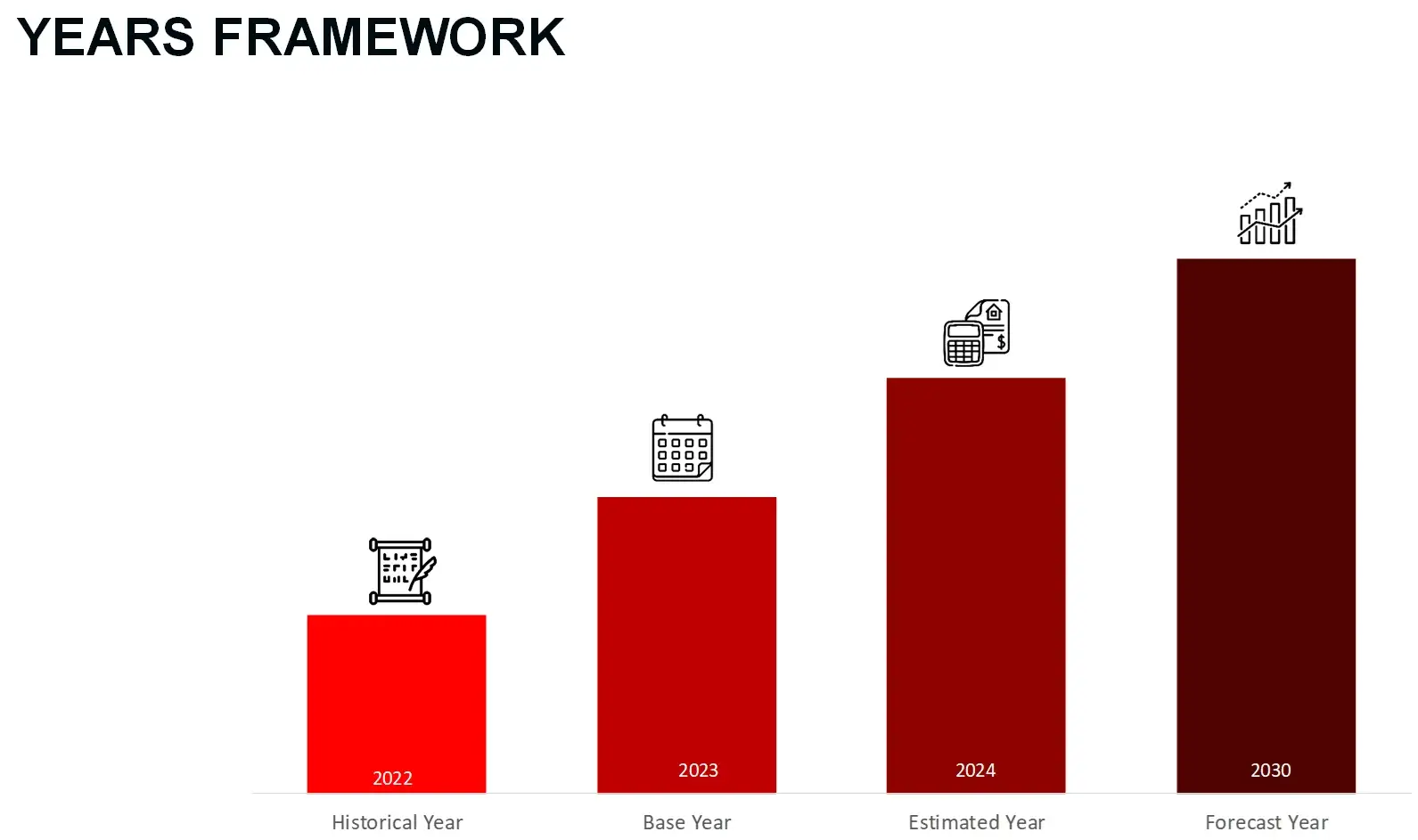
Key Stakeholders
Key objectives of the Study
Research Methodology
The aim of the study is to examine the key market forces such as drivers, opportunities, restraints, challenges, and strategies of key leaders. To monitor company advancements such as patents granted, product launches, expansions, and collaborations of key players, analyzing their competitive landscape based on various parameters of business and product strategy. Markey size has been estimated using top-down and bottom-up approaches. Using market breakdown and data triangulation techniques, market sizing of segments and sub-segments has been estimated.
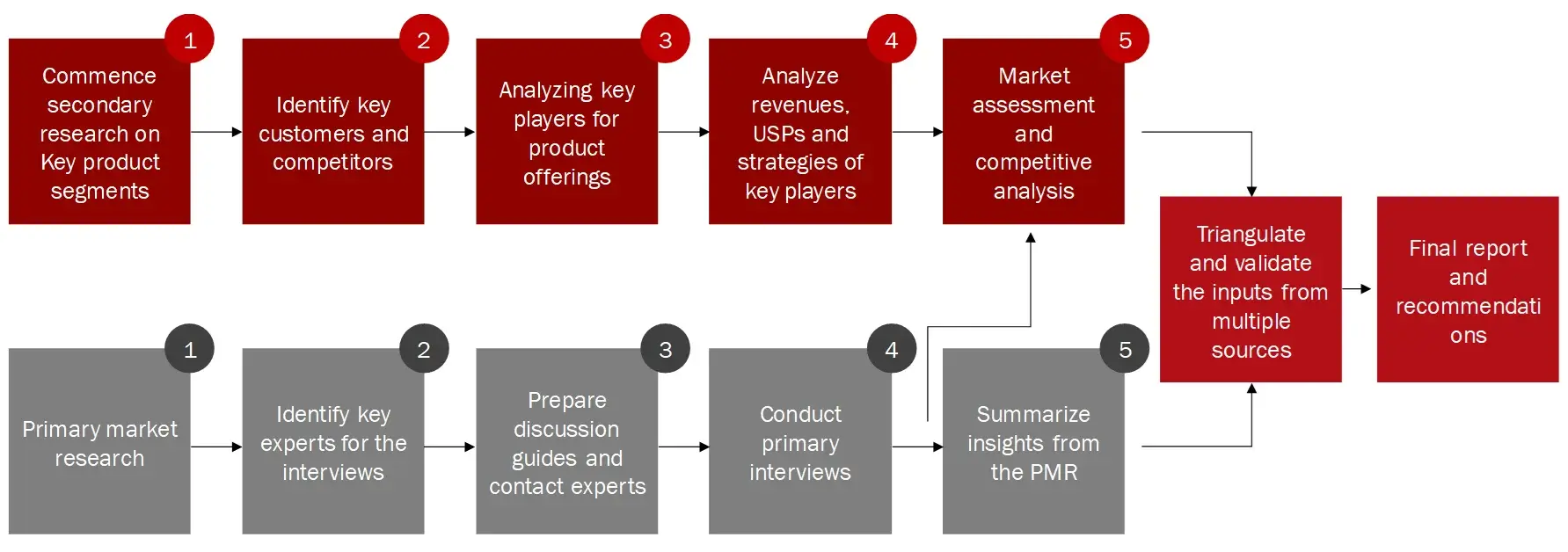
FIGURE: RESEARCH DESIGN
Research Approach
Collecting Secondary Data
The research study involves various secondary sources, directories such as Bloomberg business, Factiva, and Wall Street Journals, white papers, annual reports, company house documents, investor presentation, and SEC filings of the companies.
The secondary research approach will be used to identify and collect information useful for the extensive, technical, market oriented and commercial study of the savory ingredients market. It will also be used to obtain important information about key players, market classification, and segments according to industry trends and key developments related to the market perspectives. A database of the key industry leaders will also be prepared using secondary research.
Collecting Primary Data
The primary research data will be conducted after acquiring knowledge about the savory ingredients market scenario through secondary research. A significant number of primary interviews will be conducted with stakeholders from both the demand and supply side (including various industry experts, such as Vice Presidents (VPs), Chief X Officers (CXOs), Directors from business development, marketing and product development teams, product manufacturers) across major countries of Europe, Asia-Pacific, North America, Latin America, and Middle East. Primary data for this report will be collected through questionnaires, emails, and telephonic interviews.
FIGURE: BREAKDOWN OF PRIMARY INTERVIEWS FROM SUPPLY SIDE
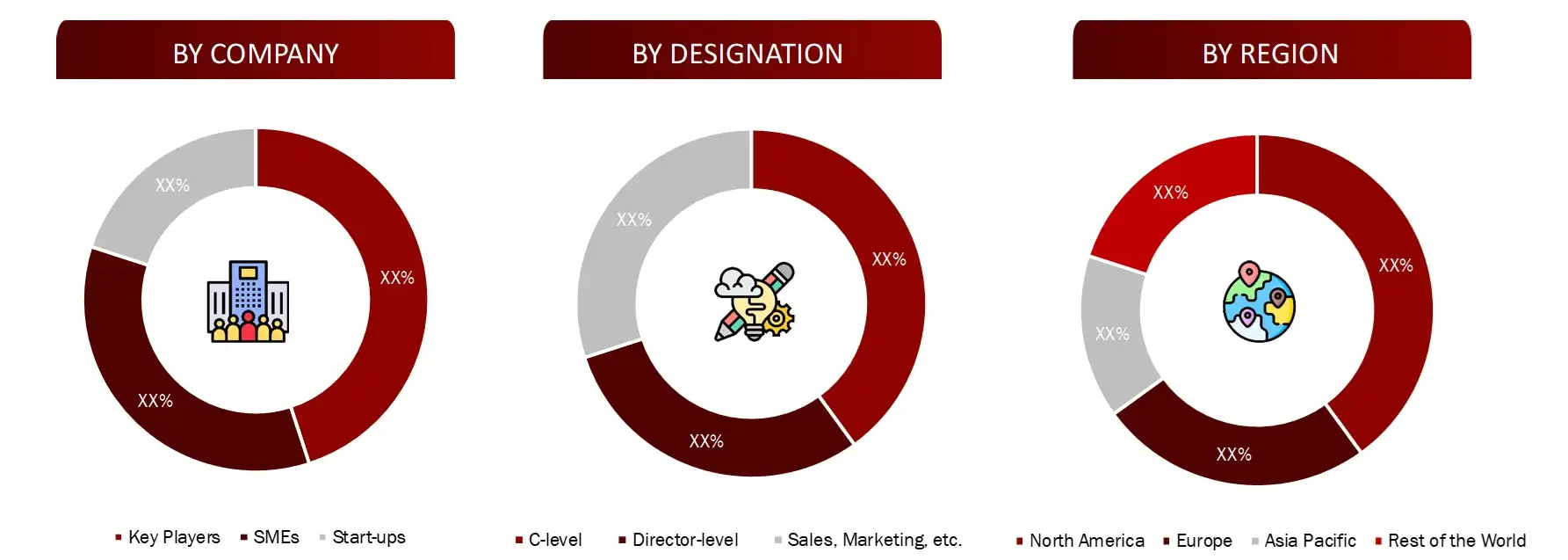 FIGURE: BREAKDOWN OF PRIMARY INTERVIEWS FROM DEMAND SIDE
FIGURE: BREAKDOWN OF PRIMARY INTERVIEWS FROM DEMAND SIDE
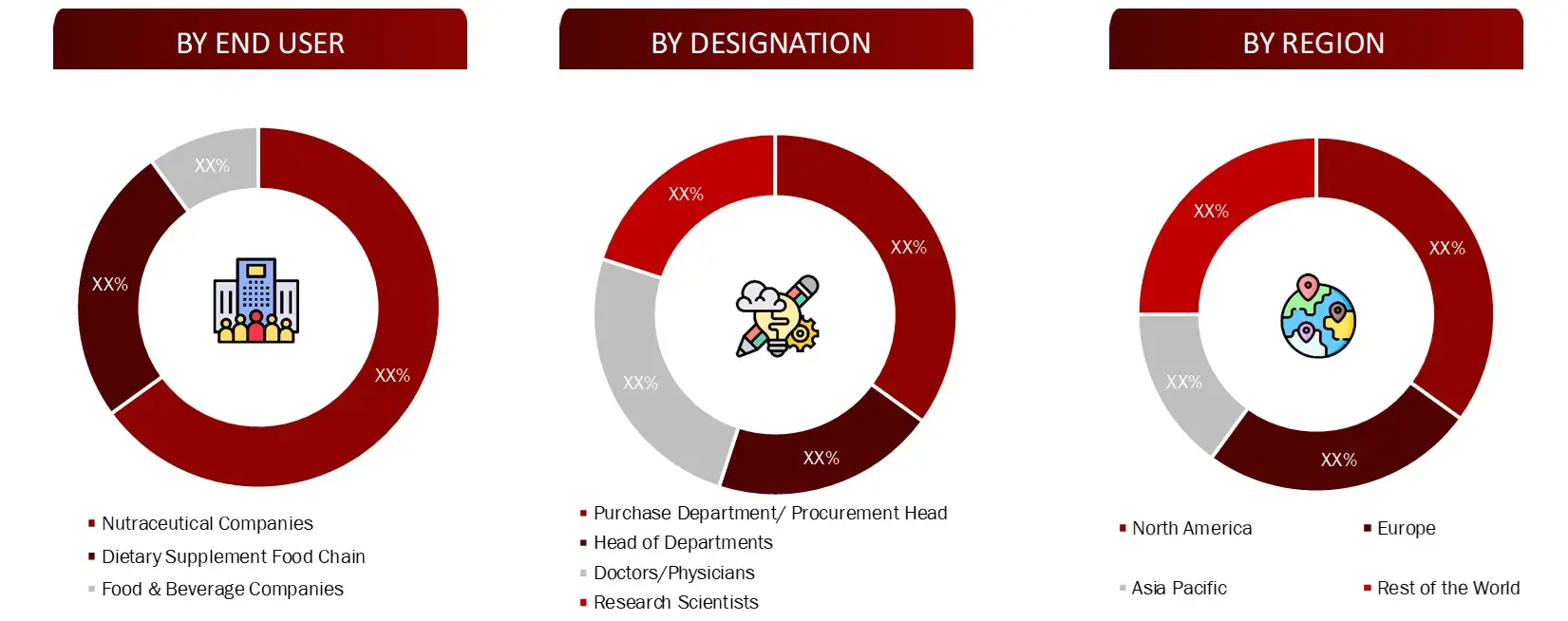
FIGURE: PROPOSED PRIMARY PARTICIPANTS FROM DEMAND AND SUPPLY SIDE
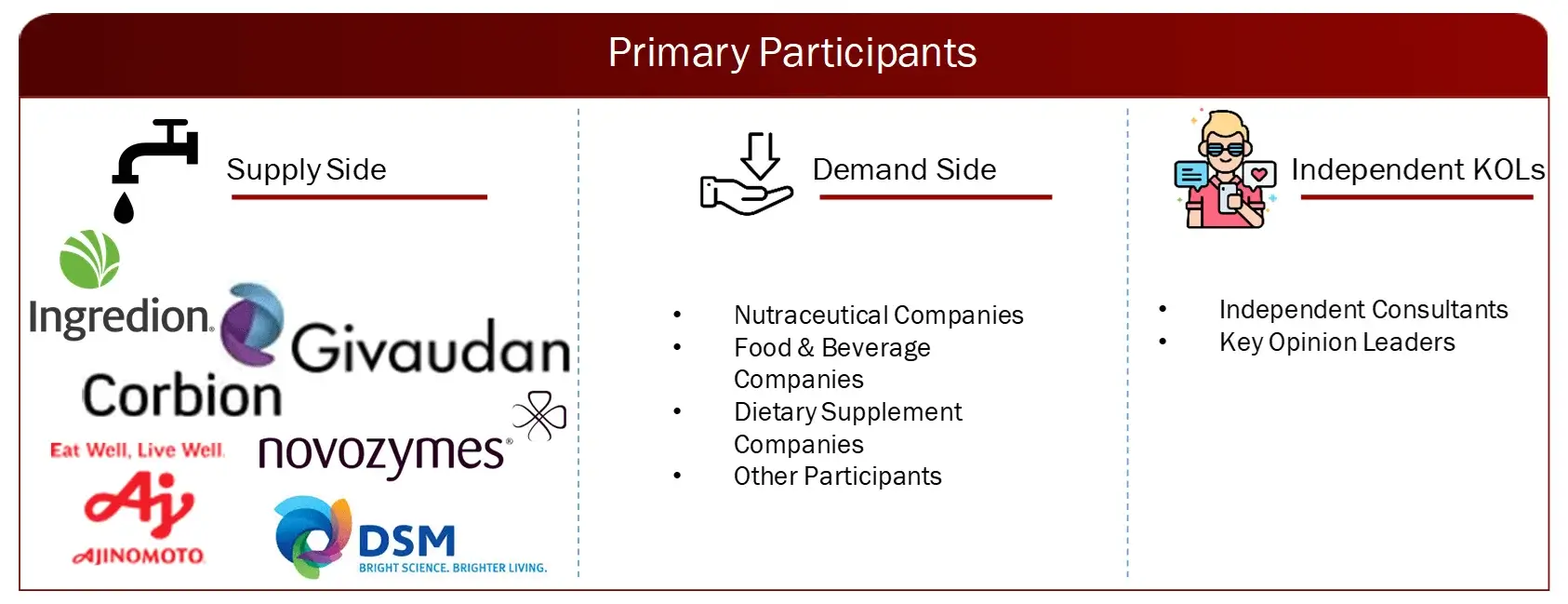
Market Size Estimation
All major manufacturers offering various savory ingredients will be identified at the global/regional level. Revenue mapping will be done for the major players, which will further be extrapolated to arrive at the global market value of each type of segment. The market value of savory ingredients market will also split into various segments and sub segments at the region level based on:
FIGURE: SUPPLY SIDE (ILLUSTRATION)
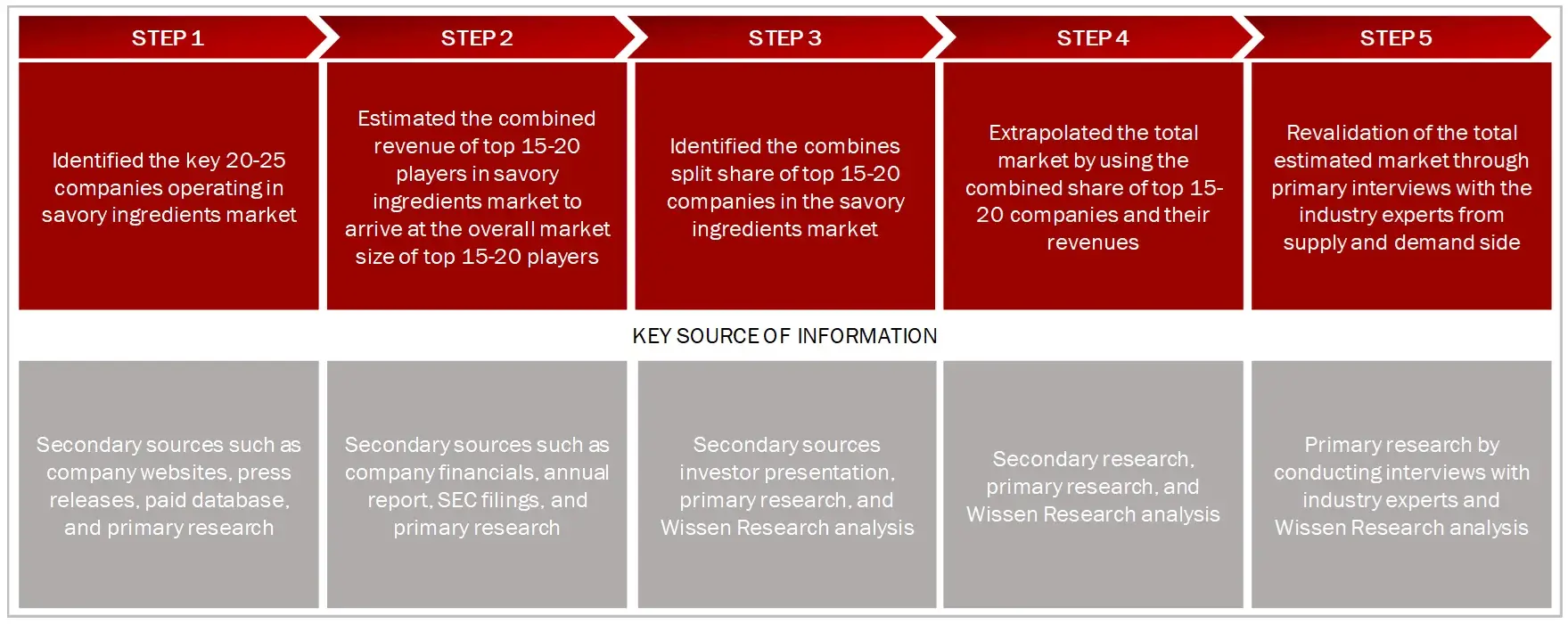
FIGURE: REVENUE SHARE ANALYSIS OF KEY PLAYERS (SUPPLY SIDE)
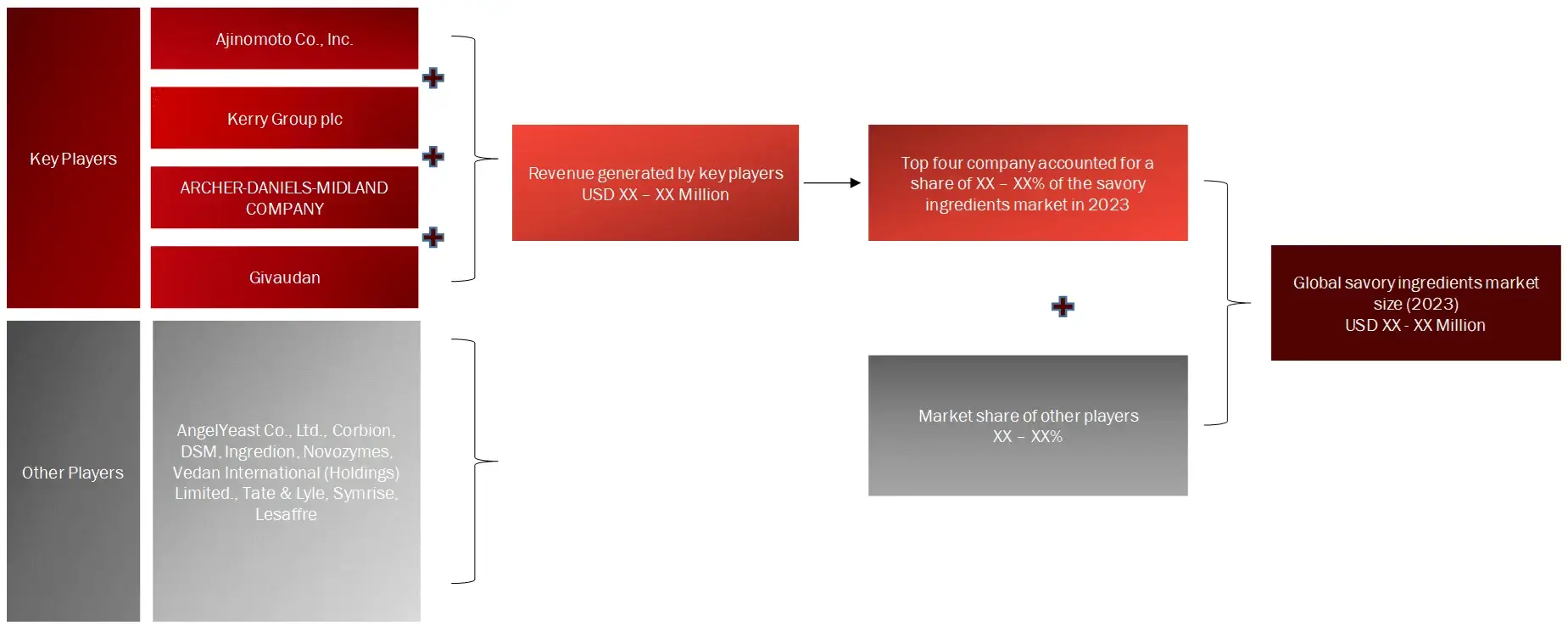
FIGURE: MARKET SIZE ESTIMATION TOP-DOWN AND BOTTOM-UP APPROACH
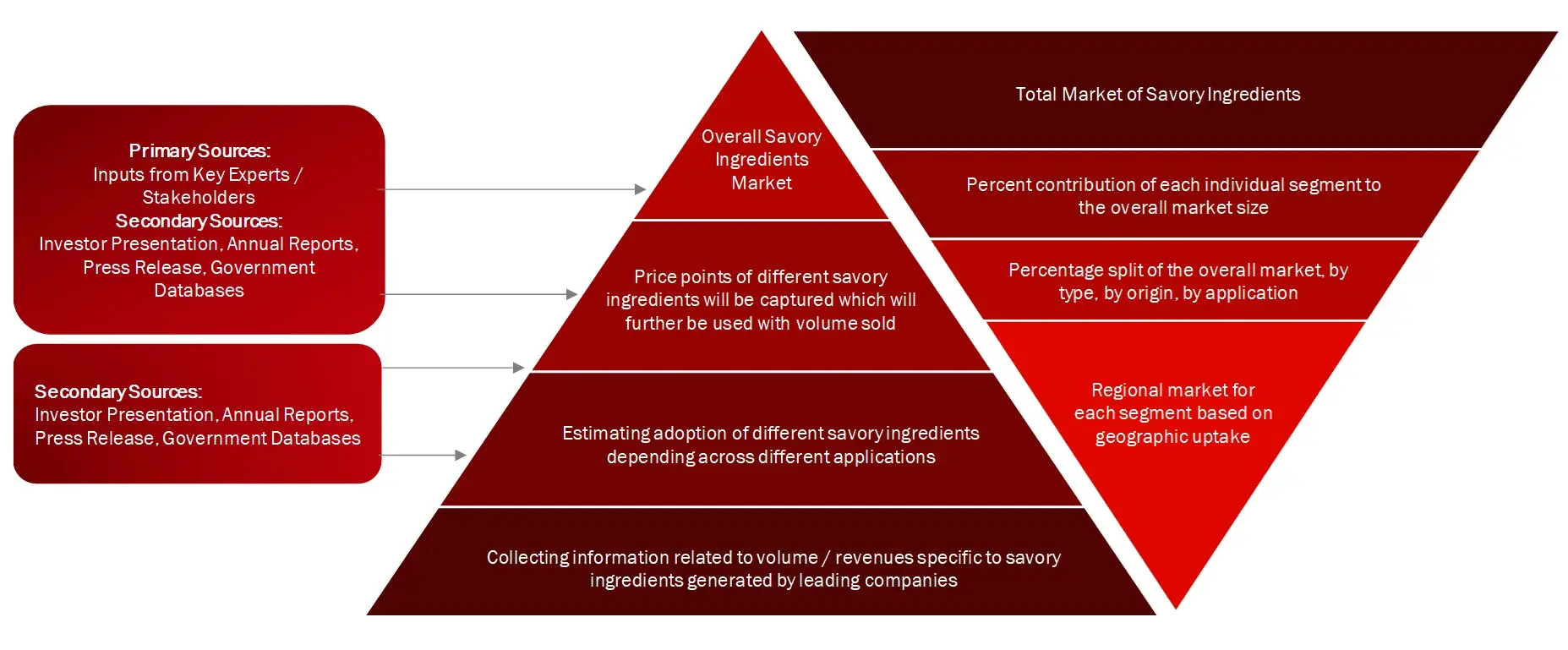
FIGURE: ANALYSIS OF DROCS FOR GROWTH FORECAST
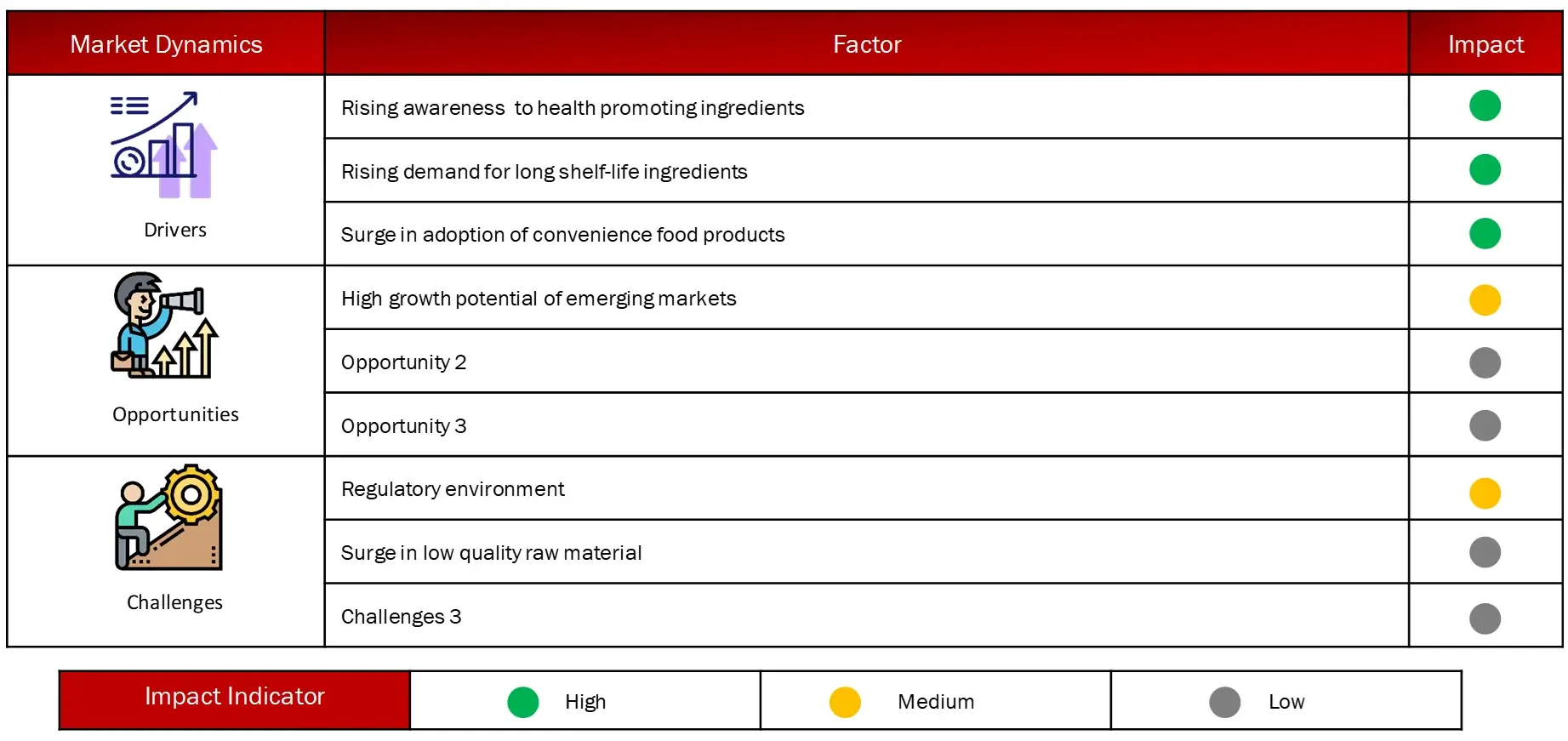
FIGURE: GROWTH FORECAST ANALYSIS UTILIZING MULTIPLE PARAMETERS
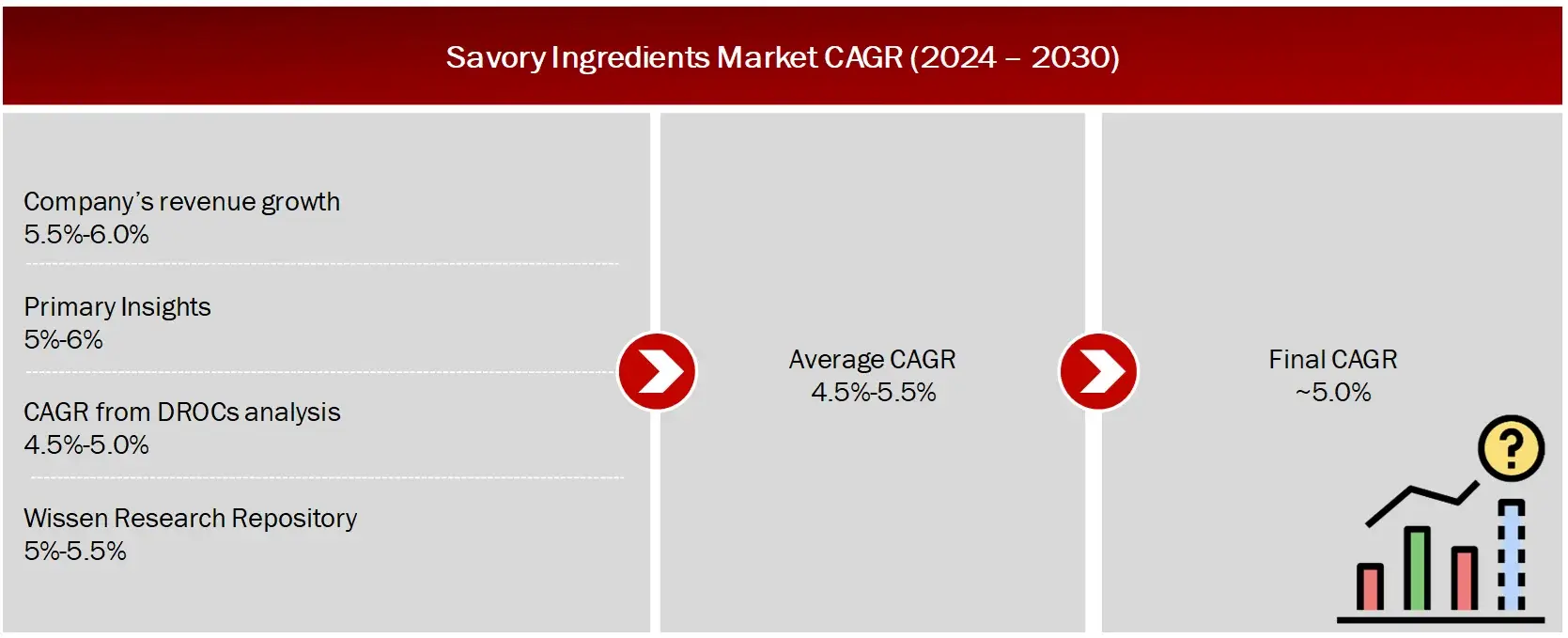
Research Design
Data triangulation involved the combination of primary research, secondary research, and the Wissen Research Analysis. Once the data points will be sourced from the secondary market research, we sanitize the data points to make the market sizing and growth forecast more accurate by developing our own assumptions based on the inputs and insights we gather through the primary interviews with the industry experts. Once the data will be thoroughly validated through primary interviews from both, demand and supply side of the market, our team of analyst and other team members involved finalize the market sizing and growth forecast.
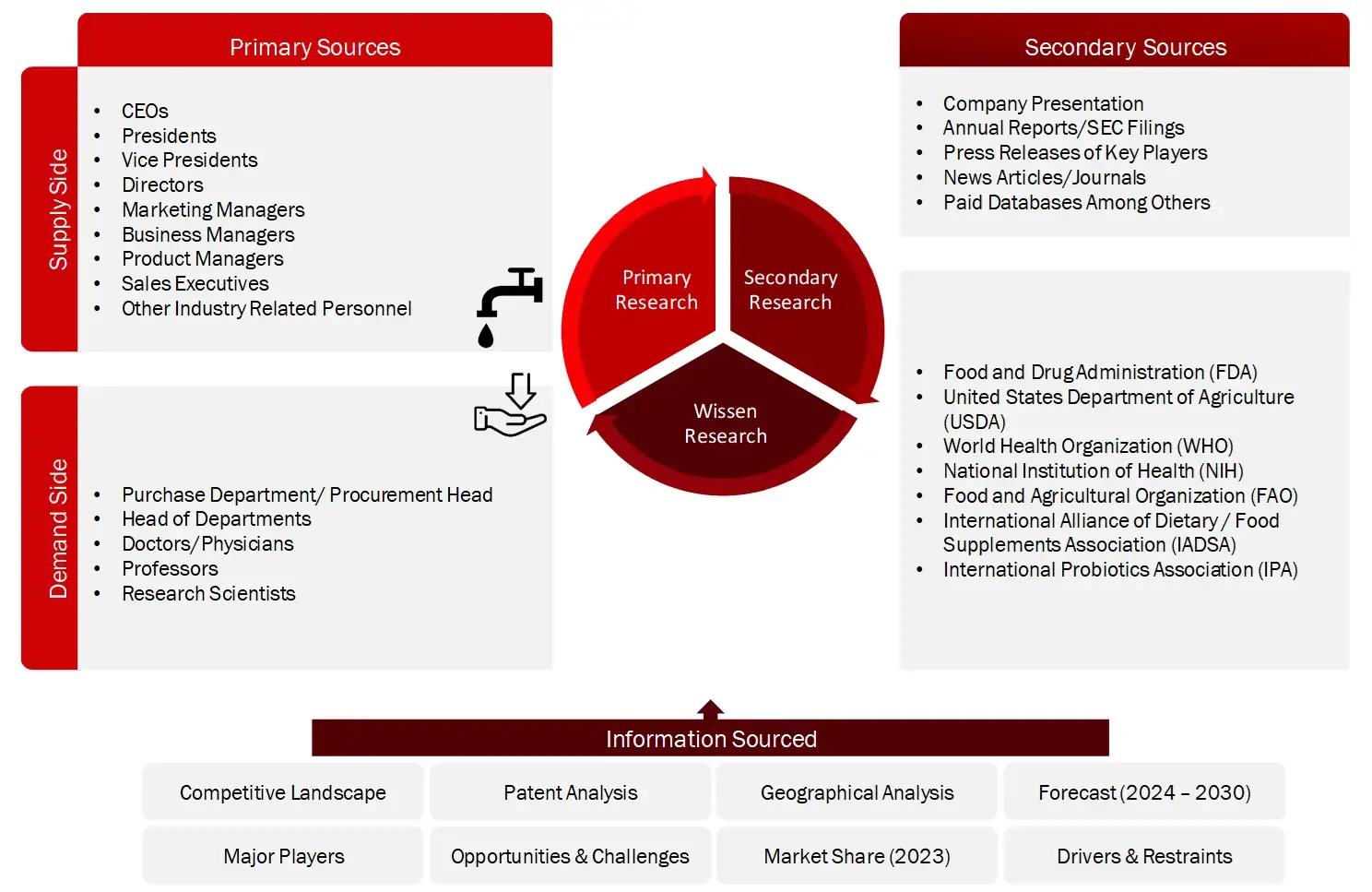
1. Introduction
1.1 Key Objectives
1.2 Definitions
1.2.1 In Scope
1.2.2 Out of Scope
1.3 Scope of the Report
1.4 Scope Related Limitations
1.5 Key Stakeholders
2. Research Methodology
2.1 Research Approach
2.2 Research Methodology / Design
2.3 Market Sizing Approach
2.3.1 Secondary Research
2.3.2 Primary Research
3. Executive Summary & Premium Content
3.1 Global Market Outlook
3.2 Key Market Findings
4. Market Overview
4.1 Market Dynamics
4.1.1 Drivers/Opportunities
4.1.2 Restraints/Challenges
4.2 End User Perception
4.3 Need Gap
4.4 Supply Chain / Value Chain Analysis
4.5 Industry Trends
4.6 Porter’s Five Forces Analysis
5. Patent Analysis
5.1 Patents Related to Savory Ingredients
5.2 Patent Landscape and Intellectual Property Trends
6. Global Savory Ingredients Market, by Type (2023-2030, USD Million)
6.1 Yeast Extracts
6.2 Hydrolyzed Vegetable Proteins
6.3 Monosodium Glutamate
6.4 Nucleotides
6.5 Other Ingredients
7. Global Savory Ingredients Market, by Origin (2023-2030, USD Million)
7.1 Natural
7.2 Synthetic
8. Global Savory Ingredients Market, by Application (2023-2030, USD Million)
8.1 Food and Beverages
8.2 Snacks
8.3 Soups and Sauces
8.4 Prepared Meals
8.5 Processed Meat
8.6 Convenience Food
8.7 Other Food and Beverages
8.8 Pharmaceuticals
8.9 Feeds
8.10 Other Applications
9. Global Savory Ingredients Market by, Region (2023-2030, USD Million)
9.1 North America
9.1.1 US
9.1.2 Canada
9.2 Europe
9.2.1 Germany
9.2.2 France
9.2.3 Spain
9.2.4 Italy
9.2.5 UK
9.2.6 Rest of the Europe
9.3 Asia-Pacific
9.3.1 China
9.3.2 Japan
9.3.3 India
9.3.4 Australia and New Zealand
9.3.5 South Korea
9.3.6 Rest of the Asia-Pacific
9.4 Middle East and Africa
9.5 Latin America
10. Competitive Analysis
10.1 Key Players Footprint Analysis
10.2 Market Share Analysis
10.3 Key Brand Analysis
10.4 Regional Snapshot of Key Players
10.5 R&D Expenditure of Key Players
11. Company Profiles2
11.1 Ajinomoto Co., Inc.
11.1.1 Business Overview
11.1.2 Product Portfolio
11.1.3 Financial Snapshot3
11.1.4 Recent Developments
11.2 Archer-Daniels-Midland Company
11.3 DSM
11.4 Kerry Group plc.
11.5 Givaudan
11.6 Cargill Incorporated
11.7 Ingredion
11.8 Lesaffre
11.9 Novozymes
11.10 Symrise
11.11 Tate & Lyle
12. Conclusion
13. Appendix
13.1 Industry Speak
13.2 Questionnaire
13.3 Available Custom Work
13.4 Adjacent Studies
13.5 Authors
14. References
Key Notes:
Note 1 – Contents in the ToC / market segments are tentative and might change as the research proceeds.
Note 2 – List of companies is not exhaustive and might change during the course of study.
Note 3 – Details on key financials might not be captured in case of unlisted companies.
Note 4 – SWOT analysis will be provided for top 3-5 companies.
Note 5 – In scope and out of scope will be provided in detail during the course of the study.
© Copyright 2024 – Wissen Research All Rights Reserved.